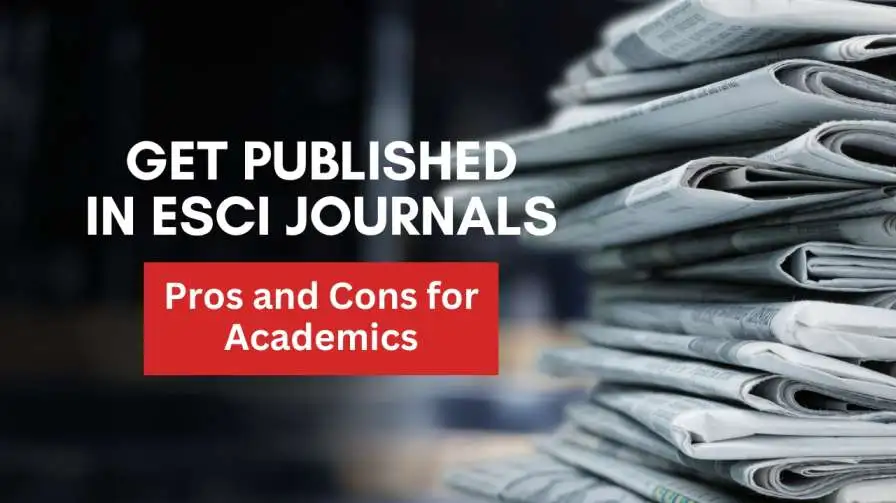The adventure to academic publishing can be a tough task, with researchers searching for reliable retailers to disseminate their findings. ESCI (Emerging Sources Citation Index) journals provide a promising platform, particularly for emerging students aiming to establish a solid foundation in their fields. Understanding what ESCI journals provide, and the professionals and cons associated with publishing in them are crucial for knowledgeable choices on wherein to post. Let‘s delve deeper to know everything from the fundamentals, like the meaning and purpose of ESCI journals, to sensible recommendations on getting posted in those journals and comparing the advantages and disadvantages for professionals.
What is ESCI?
ESCI Full Form and Meaning The full form of ESCI is the Emerging Sources Citation Index. It is a database of journals under the Web of Science Journal list controlled by way of Analytics. The means of ESCI lies in its project to symbolize satisfactory journals from rising scientific fields and regions. Unlike greater mounted indices like the Science Citation Index (SCI) or Social Sciences Citation Index (SSCI), ESCI journals are not fully listed on the Web of Science but are nonetheless held to certain rigorous requirements.
ESCI vs. Other Indices While journals within the ESCI are taken into consideration notably, they vary from SCI, SSCI, and Arts and Humanities Citation Index (AHCI) journals in that they will not yet have an Impact Factor. However, inclusion in the ESCI is mostly a precursor to turning into indexed in SCI or SSCI, because it signifies recognition by the Web of Science and shows adherence to first-class research standards.
How to Get Published in ESCI Journals: A Step-by way of-Step Guide
- Identify Relevant ESCI Journals: Start by reviewing the ESCI journal listing, that’s updated regularly. Researchers can discover the ESCI journal list 2024 at the Web of Science website or through their group’s library portal. Select journals aligned together with your studies field, subject matter, and the kind of study you’ve performed
- Understand the Journal’s Scope and Audience: Every ESCI journal has a unique scope, regularly unique at the journal’s respectable internet site. Tailor your article to fulfill the expectancies of the audience and align with the journal’s consciousness.
- Review Past Issues and Published Articles: Familiarize yourself with the structure, writing style, and forms of studies generally published within the journal. This perception will help you in shape your manuscript’s layout and content to the journals standards.
- Prepare a Quality Manuscript: A quality manuscript’s satisfaction is paramount for popularity. Ensure your study is meticulously organized, with clear studies questions, thorough literature opinions, and a robust method section.
Review the journal’s submission pointers on layout, quotation style, and phrase limits. - Follow the Journal’s Submission Guidelines: Every journal has specific submission criteria, such as format, quotation style, figures, tables, and referencing. Adherence to these essential tips indicates professionalism and may prevent rejection in any case.
- Academic Credibility and Visibility:
ESCI journals undergo an intensive assessment manner with the aid of Web of Science. Thus, publishing in those journals offers a stage of credibility and recognition. Researchers gain visibility within their academic community, that may lead to extended citations, networking opportunities, and collaboration gives. - Inclusion within the Web of Science Platform:
ESCI is part of the Web of Science Core Collection, which means that articles posted in ESCI journals are indexed and discoverable by way of researchers globally.
Being indexed additionally provides a pathway to greater recognized citation indices, growing the likelihood of citation and publicity. -
Potential for Transition to Impact Factor Journals:
Many ESCI journals transition to SCI or SSCI reputation after they’ve established their effect and fine. Publishing in an ESCI magazine can thus be a stepping stone to even more prestigious courses. -
Expanding Research Horizons: ESCI journals regularly cowl new and rising fields that might not but have specialized SCI-listed journals. Researchers in these fields can make contributions to pioneering work, putting the inspiration for further examine.
-
Accessibility for Early-Career Researchers: ESCI journals are on occasion less aggressive as compared to SCI and SSCI journals, presenting a valuable opportunity for early-profession researchers to advantage revel in with the publication technique.
- Academic Credibility and Visibility:
Cons of Publishing in ESCI Journals
- Lack of Impact Factor: ESCI journals no longer have an reputable Impact Factor, which may additionally have an effect on their perceived status amongst lecturers. This may be a drawback if you’re in search of positions or promotions that prioritize excessive-effect courses.
- Perceived Lower Status: Some academic establishments and funding agencies may also view ESCI journals as less prestigious than SCI or SSCI journals. Depending on your area and, publishing in ESCI journals may not carry the equal weight in opinions.
- Longer Time to Recognition: While many ESCI journals transition to SCI or SSCI, it could take years for this to occur. If your eBook is tied to on-the-spot profession milestones, you would possibly need to recollect faster-effect options.
- Limited Influence in High-Stakes Fields: In positive excessive-stakes fields, which includes medicine, publishing in ESCI journals won’t preserve the identical value as SCI or SSCI journals because of the absence of an Impact Factor.
- Rigid Requirements and Peer Review: Like other listed journals, ESCI journals require adherence to stringent requirements, and peer review methods can be rigorous. While this is useful for research pleasant, it is able to be tough and time-consuming for authors.
Making the Choice: Is Publishing in ESCI Right for You?
Publishing in ESCI journals is precious for teachers, mainly for early-profession researchers and those in rising fields. However, it’s important to consider your dreams, career level, and area necessities. Here’s a brief guideline to assist make the choice:
- Career Goals: If your career benefits from high-impact courses, ESCI may additionally serve as a steppingstone. Conversely, if you’re in an emerging aspirant in which effect elements are much less relevant, ESCI journals may be perfect.
- Institutional Requirements: Check along with your group or investment corporation to peer if ESCI guides are identified in evaluations. Some establishments may additionally value ESCI guides, particularly if they’re looking for visibility in emerging research regions.
- Research Field: For researchers in fields with many SCI and SSCI journals, ESCI can be seen as less impactful. However, for those in interdisciplinary or new regions, ESCI journals are regularly a respected outlet.
- Timeline and Availability: Publishing in ESCI journals may be a feasible alternative in case you’re aiming for a good index but don’t want to attend if SCI and SSCI guides regularly require.
Summing Up
Publishing in ESCI journals gives academics an on-hand experience for building credibility, specifically inside emerging or interdisciplinary studies fields. While ESCI journals won’t provide Impact Factors, they nonetheless represent various essential achievements, fostering visibility and scholarly engagement.
Ultimately, lecturers need to weigh the professionals and cons of ESCI journals, considering their professional degree, institutional necessities, and research discipline. For those in emerging disciplines or seeking professional but accessible publishing opportunities, ESCI journals are a valuable help which is, potentially paving the way to even better-effect achievements in the future.
Frequently Asked Questions (FAQs)
The full form of ESCI is the Emerging Sources Citation Index. It is part of the Web of Science Core Collection that consists of journals from emerging studies fields and regions. ESCI journals are professional and comply with rigorous high-quality standards but might not but have an Impact Factor.
You can get entry to the ESCI journal list through the Web of Science platform or consult your institution’s library. The list is up to date often, so take a look at journals that align together with your research place and goals.
No, ESCI journals no longer have an Impact Factor. However, they're listed and identified by the Web of Science, which frequently makes them a terrific place to begin for early-career researchers. Many ESCI journals can transition to Impact Factor fame through the years.
ESCI journals offer visibility, educational credibility, and accessibility for rising researchers. They offer a respected platform for brand new fields of look at and may help to take advantage of popularity inside the broader research community.
While ESCI journals are of fine standard, they are considered less prestigious than SCI or SSCI journals. Additionally, they lack an Impact Factor, which may have an effect on recognition in some fields. Peer review methods are also rigorous, requiring time and adherence to particular submission guidelines.






